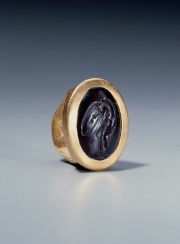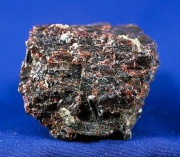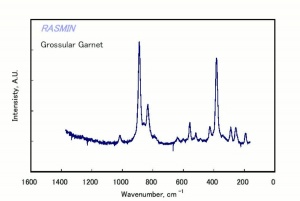Difference between revisions of "Fluorescent minerals"
(Created page with "== Description == test1 test test &epsilon (from help page - doesn't seem to work) for instance m (from your email - the mu did not insert) µ (from my computer) For i...") |
|||
| Line 1: | Line 1: | ||
| + | [[File:21.1213-CR2071-d1.jpg|thumb|]] | ||
== Description == | == Description == | ||
| − | + | A family of minerals composed of trisilicates with [[aluminum]], [[iron]], [[calcium]], [[magnesium]], [[manganese]], or [[chromium]]. Garnets are found in deposits around the world as transparent crystals embedded in igneous and metamorphic rocks. They have been used as gemstones since antiquity. The ruby red [[pyrope]] and the lighter red [[almandine]] were the most highly prized varieties. The pale rose-purple [[rhodolite]] is a mixture of pyrope and almandine. Garnets are also used as abrasives. The crushed, ground and cleaned garnet is sold as an abrasive powder, coated paper and coated cloth. Garnet particles have sharper cutting edges than aluminum oxide, but are expensive. To decrease costs, some commercially available garnet cloths are actually prepared with quartz. Sources of gem quality garnets include the Czech Republic, South Africa, Australia, China, India, Brazil, Sri Lanka, and the U.S (New York, Maine, Idaho). | |
| − | + | [[File:Garnetemr2.jpg|thumb|Garnet]] | |
| − | + | == Synonyms and Related Terms == | |
| + | |||
| + | pyrope (deep red to black); almandine (deep red to black); spessartine (red to brown); grossularite (green); grossular (colorless); carbuncle; andradite (wine red); uvarovite (emerald green); tsavorite (Green); rhodolite (pale red to purple); hessonite (golden); topazolite; demantoid; melanite; Uralian emeralds; Greek anthrax; Granat (Deut.); granate (Esp.); grenat (Fr.); granaat (Ned.); granada (Port.); granatus (Lat.) | ||
| + | |||
| + | == Other Properties == | ||
| + | |||
| + | Isometric crystal system with dodecahedron and trapezohedron habits. | ||
| + | |||
| + | Luster = vitreous to resinous. Fracture = conchoidal or uneven. Streak = colorless to white | ||
| + | |||
| + | Fluorescence = none (except green ones which may give weak yellow-orange colors) | ||
| − | + | {| class="wikitable" | |
| + | |- | ||
| + | ! scope="row"| Mineral | ||
| + | | Composition | ||
| + | | Visible color | ||
| + | | Fluorescent color | ||
| + | |- | ||
| + | ! scope="row"| Agate | ||
| + | | PbCO3 | ||
| + | | colorless to white | ||
| + | | yellowish | ||
| + | |- | ||
| + | ! scope="row"| Apatite | ||
| + | | PbCO3 | ||
| + | | colorless to white | ||
| + | | yellowish | ||
| + | |- | ||
| + | ! scope="row"| Barite | ||
| + | | PbCO3 | ||
| + | | colorless to white | ||
| + | | yellowish | ||
| + | |- | ||
| + | ! scope="row"| Calcite | ||
| + | | PbCO3 | ||
| + | | colorless to white | ||
| + | | yellowish | ||
| + | |- | ||
| + | ! scope="row"| Cerrusite | ||
| + | | PbCO3 | ||
| + | | colorless to white | ||
| + | | yellowish | ||
| + | |- | ||
| + | ! scope="row"| Chalcedony | ||
| + | | PbCO3 | ||
| + | | colorless to white | ||
| + | | yellowish | ||
| + | |- | ||
| + | ! scope="row"| Corundum | ||
| + | | PbCO3 | ||
| + | | colorless to white | ||
| + | | yellowish | ||
| + | |- | ||
| + | ! scope="row"| Dolomite | ||
| + | | PbCO3 | ||
| + | | colorless to white | ||
| + | | yellowish | ||
| + | |- | ||
| + | ! scope="row"| Fluorite | ||
| + | | PbCO3 | ||
| + | | colorless to white | ||
| + | | yellowish | ||
| + | |- | ||
| + | ! scope="row"| Quartz | ||
| + | | SiO23 | ||
| + | | colorless to white | ||
| + | | red | ||
| + | |- | ||
| + | ! scope="row"| Rhyolite | ||
| + | | PbCO3 | ||
| + | | colorless to white | ||
| + | | yellowish | ||
| + | |- | ||
| + | ! scope="row"| Scapolite | ||
| + | | PbCO3 | ||
| + | | colorless to white | ||
| + | | yellowish | ||
| + | |- | ||
| + | ! scope="row"| Willemite | ||
| + | | PbCO3 | ||
| + | | colorless to white | ||
| + | | green | ||
| + | |- | ||
| + | |} | ||
| − | + | [[[SliderGallery rightalign|garnetgrossRS.jpg~Raman]]] | |
| − | + | == Additional Information == | |
| − | == | + | J. Ogden, ''Jewelry of the Ancient World'', Rizzoli International Publications, New York, 1982. |
| + | |||
| + | == Comparisons == | ||
| + | |||
| + | [[media:download_file_171.pdf|Properties of Common Abrasives]] | ||
| + | |||
| + | [[media:download_file_412.pdf|Properties of Common Gemstones]] | ||
| − | + | [[media:download_file_413.pdf|Natural and Simulated Diamonds]] | |
| − | |||
| − | |||
[[Category:Materials database]] | [[Category:Materials database]] | ||
Revision as of 12:35, 1 May 2018
Description
A family of minerals composed of trisilicates with Aluminum, Iron, Calcium, Magnesium, Manganese, or Chromium. Garnets are found in deposits around the world as transparent crystals embedded in igneous and metamorphic rocks. They have been used as gemstones since antiquity. The ruby red Pyrope and the lighter red Almandine were the most highly prized varieties. The pale rose-purple Rhodolite is a mixture of pyrope and almandine. Garnets are also used as abrasives. The crushed, ground and cleaned garnet is sold as an abrasive powder, coated paper and coated cloth. Garnet particles have sharper cutting edges than aluminum oxide, but are expensive. To decrease costs, some commercially available garnet cloths are actually prepared with quartz. Sources of gem quality garnets include the Czech Republic, South Africa, Australia, China, India, Brazil, Sri Lanka, and the U.S (New York, Maine, Idaho).
Synonyms and Related Terms
pyrope (deep red to black); almandine (deep red to black); spessartine (red to brown); grossularite (green); grossular (colorless); carbuncle; andradite (wine red); uvarovite (emerald green); tsavorite (Green); rhodolite (pale red to purple); hessonite (golden); topazolite; demantoid; melanite; Uralian emeralds; Greek anthrax; Granat (Deut.); granate (Esp.); grenat (Fr.); granaat (Ned.); granada (Port.); granatus (Lat.)
Other Properties
Isometric crystal system with dodecahedron and trapezohedron habits.
Luster = vitreous to resinous. Fracture = conchoidal or uneven. Streak = colorless to white
Fluorescence = none (except green ones which may give weak yellow-orange colors)
| Mineral | Composition | Visible color | Fluorescent color |
|---|---|---|---|
| Agate | PbCO3 | colorless to white | yellowish |
| Apatite | PbCO3 | colorless to white | yellowish |
| Barite | PbCO3 | colorless to white | yellowish |
| Calcite | PbCO3 | colorless to white | yellowish |
| Cerrusite | PbCO3 | colorless to white | yellowish |
| Chalcedony | PbCO3 | colorless to white | yellowish |
| Corundum | PbCO3 | colorless to white | yellowish |
| Dolomite | PbCO3 | colorless to white | yellowish |
| Fluorite | PbCO3 | colorless to white | yellowish |
| Quartz | SiO23 | colorless to white | red |
| Rhyolite | PbCO3 | colorless to white | yellowish |
| Scapolite | PbCO3 | colorless to white | yellowish |
| Willemite | PbCO3 | colorless to white | green |
Additional Information
J. Ogden, Jewelry of the Ancient World, Rizzoli International Publications, New York, 1982.
Comparisons
Properties of Common Abrasives
Properties of Common Gemstones
Natural and Simulated Diamonds


